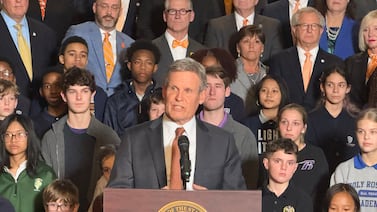Denver airport leaders are considering building a child care center — maybe more than one — to help recruit and retain employees at the growing airport campus.
To further study the concept, the airport hopes to win City Council approval Monday for a 3-year, $800,000 contract with a Denver advocacy group that will assist with research and planning. A council committee already approved the proposal on April 10.
The airport’s plan reflects the reality that child care — or the lack thereof — can have big economic consequences for employers that rely on working parents to fill their ranks. More than 40,000 employees, ranging from aviation officials to janitorial staff, work at the airport, which is the country’s third busiest. There are so few state-licensed child care options near the airport in far northeast Denver, it’s considered a child care desert.
Airport officials say they have many questions to answer before committing to a child care center or some other form of employee child care support, but suggested their eventual decision could be momentous.
“We’re on a global stage and we have the ability to do something really special,” said Andrea Albo, deputy chief of staff for Denver International Airport, which is owned and operated by the city.
She said project leaders will carefully consider the needs of the airport’s lowest wage earners and historically marginalized communities in deciding how to proceed. A final decision is likely by spring of 2026.
Nicole Riehl, president and CEO of Executives Partnering to Invest in Children, the group being considered for the $800,000 contract, said employers aren’t a panacea for child care challenges but can help build up child care supply.
“Employers can’t just sit around and wait for the federal government to fix it or the states to fix it,” she said.
Other U.S. airports offer child care
If the Denver airport moves forward with a child care center, it will join a handful of other American airports that already offer on-campus child care, or soon will, including Los Angeles International Airport, Pittsburgh International Airport, and, starting in 2025, Phoenix Sky Harbor International Airport.
Sky Harbor’s child care efforts were born during the pandemic, said Matt Heil, the airport’s deputy aviation director for strategy, policy, and administration.
“We had nowhere near the traffic, but we still had to have all the operations up and running,” he said. “It was a priority to make sure we could continue to do what we could to support workers.”
The Phoenix City Council agreed to use $5 million in federal COVID relief money to help fund a two-pronged approach to child care help.
Starting in 2022, Sky Harbor launched sliding scale child care scholarships for employees who earn up to 400% of the federal poverty guidelines — $124,800 for a family of four. About 40 households currently receive the scholarships, which can be used at child care facilities across Maricopa County, Heil said.
The other half of the plan is a soon-to-be-built child care center for up to 100 children on the airport campus. It’s slated to open in 2025.
Placing a child care center at an airport is complicated, Heil said. It needs to be accessible and convenient for employees, while having enough separation from the terminal that long lines, tight security, and abandoned-suitcase incidents won’t jeopardize its operations.
In addition, space is limited on Sky Harbor’s campus in southeast Phoenix. Officials there settled on a site in a courtyard under a Sky Train station near an employee parking lot.
Heil said helping parents with small children secure child care can incentivize them to work at the airport.
“If you talk to other airports, this is definitely an ongoing conversation in the industry,” he said.
How big a role should employers play in child care?
When Stephanie Burke moved to Denver two years ago to start as director of the airport’s Center of Equity and Excellence in Aviation, she struggled to find child care for her two boys, then 11 months old and 3 years old.
She found a spot for her 3-year-old son, but nothing for the baby, so her husband stopped working for 11 months and stayed home with him. At that point, they found a neighbor who was willing to watch him until they found a permanent spot.
“My story is not unique,” said Burke, who is helping lead the airport’s child care effort. “It’s something that we hear from other employees … the wait lists are really long, you have to get on before you even think about having a child or when you’re in your early pregnancy.”
Burke said there are plenty of anecdotal stories, but the airport still needs to collect concrete data on employee needs. About 19,000 of the more than 40,000 employees at the airport fall into the 20- to 39-year-old age group, but it’s not clear how many have young children and need child care. That’s part of what the work with Executives Partnering to Invest in Children, or EPIC, will reveal.
Elliot Haspel, senior fellow at Capita, a child and family policy think tank, said the airport’s plan to study the issue makes sense and praised EPIC as a thought leader on employer-based child care.
But he also sounded a note of caution about the trend of employers launching child care programs — and the growing use of public dollars in the form of tax incentives or grants to help fund such projects. He worries that using those dollars on child care linked to a parent’s job may take away from broader public investment in a child care system that serves everyone.
“For employers writ large, we need to ask them to pay into a universal system via taxation,” he said.
In recent years, there has been a flurry of legislation to encourage employer-based child care, including a 2022 federal law that will allow semiconductor manufacturers who receive federal subsidies to use some of those dollars for child care programs.
“Employers can start to feel like a solution to child care problems, and they are not,” he said. They are “one piece of a larger puzzle.”
Ann Schimke is a senior reporter at Chalkbeat, covering early childhood issues and early literacy. Contact Ann at aschimke@chalkbeat.org.






